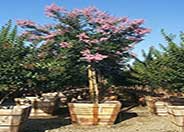
Common name:Muskogee Crape Myrtle
Botanical name:Lagerstroemia 'Muskogee'
This Crape Myrtle hybrid is a popular tree which grows to 25' tall and 12' wide. It blooms with lavender flowers in the summer; leaves turn red in fall. It is mildew resistant and does well in areas with hot summers. Crape Myrtles bloom on new wood so prune in winter or early spring to increase flowering. - Carolyn Shaffer, Dudek and Associates
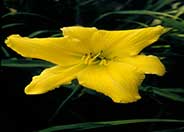
Common name:Daylily, D. Moon Hybrid
Botanical name:Hemerocallis 'D. Moon'
This Daylily has clear yellow blooms above handsome foliage. It has even bloomed in January!
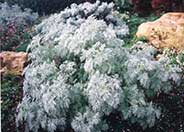
Common name:Silver Mound Artemisia
Botanical name:Artemisia schmidtiana 'Silver Mound'
This mounding perennial will grow 1'-3' high and has medium-sized silvery white leaves with yellow and white flowers.
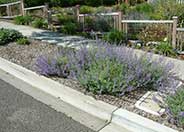
Common name:Catmint
Botanical name:Nepeta X faassenii
Nepeta faassenii makes soft, gray green, undulating mounds that are 1.5' high when blooming. The small leaves are attractive to cats. This perennial has lavender blue flowers in late spring and early summer.
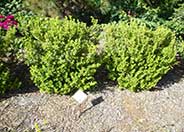
Common name:Japanese Boxwood
Botanical name:Buxus microphylla japonica
Japanese Boxwood is often used as a hedge. It is compact, with small bright green leaves. It can reach 4'-6' tall and wide or be kept smaller through pruning. It can be sheared to shape. It does better in areas with milder winters.
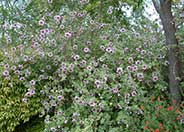
Common name:Mediterranean Tree Mallow
Botanical name:Lavatera maritima
This large, shrubby perennial grows up to 6' and has profuse lavender pink flowers with maroon highlights. From the Mallow family, the flowers are produced year round and are especially showy in the fall.
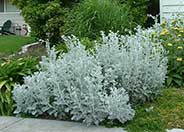
Common name:Dusty Miller, Silver Groundsel
Botanical name:Senecio cineraria
The Dusty Miller exhibits growth to 1' or more, with velvet gray leaves that have broad, roundish lobes. Yellow flower heads appear through the middle of the plant during most months of the year. Cut heads back occasionally to encourage bushiness.
Designer: Nan Simonsen Nanscapes
Photographer: GardenSoft
Maintain a two to four inch layer of mulch on the soil surface to reduce weeds, infiltrate rain water, and reduce compaction.
Fix leaking sprinklers, valves, and pipes.
One broken spray sprinkler can waste 10 gallons per minute - or 100 gallons in a typical 10 minute watering cycle.
Remove irrigation water and fertilizer from areas where you don't want weeds to grow.